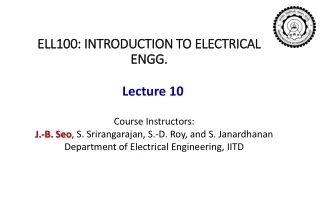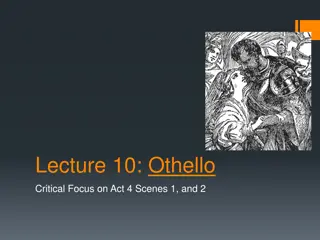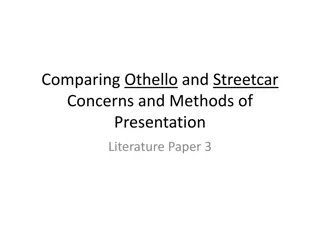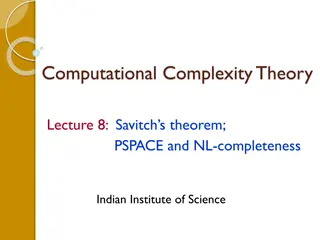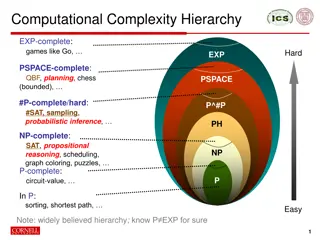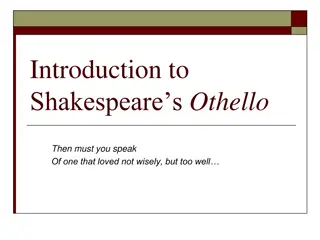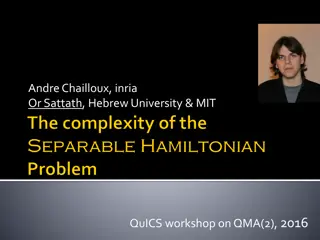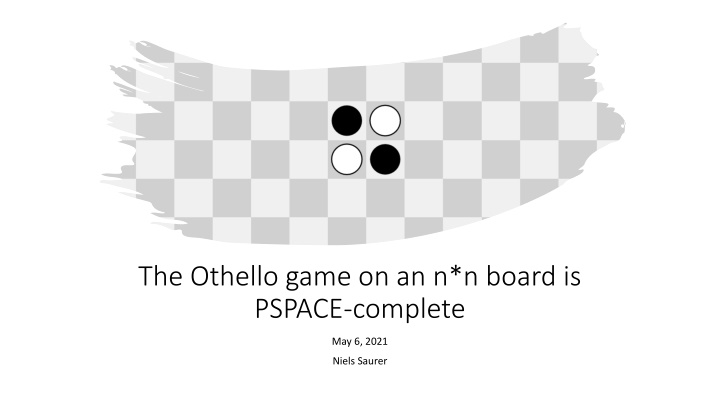
Othello Game Complexity and Strategy Insights
"Discover the complexity of the Othello game on an n*n board, its PSPACE completeness, and the strategy insights for Black to win against perfect play by White. Explore its connections to PSPACE, NP, and reduction mechanisms. Dive into the informality of proofs, TM constructions, and simulation enforcement in the context of Othello and Generalized Geography (GG)."
Download Presentation

Please find below an Image/Link to download the presentation.
The content on the website is provided AS IS for your information and personal use only. It may not be sold, licensed, or shared on other websites without obtaining consent from the author. If you encounter any issues during the download, it is possible that the publisher has removed the file from their server.
You are allowed to download the files provided on this website for personal or commercial use, subject to the condition that they are used lawfully. All files are the property of their respective owners.
The content on the website is provided AS IS for your information and personal use only. It may not be sold, licensed, or shared on other websites without obtaining consent from the author.
E N D
Presentation Transcript
The Othello game on an n*n board is PSPACE-complete May 6, 2021 Niels Saurer
Othello Two players: Black and White 8*8 board Markers ( , ) are added to the board each turn Black is first to move A move jumps over opponent s markers and converts them If a player can t make a move, he passes this move The game ends if both players pass The winner is the player with more remaining markers on the board 2
Generalized Othello 8*8 board n*n board Question: Can Black win? Perfect play by White Given initial board 3
Othello is PSPACE PSPACE-complete PSPACE Previous papers This paper Othello L Pick L = Generalized Geography (GG for short) 4
Visited Previously visited Generalized Geography (GG) Unvisited and possible option Unvisited, but illegal option and Question: Can win? 5
Othello is in PSPACE PSPACE NP: non-deterministic Turing Machines (NTM) PSPACE: alternating Turing Machines (ATM) NTM ATM NP, PSPACE: Limit depth to polynomial of input length 6
Othello is in PSPACE PSPACE Informal proof: 1. Game takes at most 2?2moves to finish 2. Game tree like ATM tree polynomial-time ATM Othello PSPACE Black s move White s move Black s move X X 7
Othello is PSPACE PSPACE- -hard hard GG Othello Provide TM A: Polynomial-time Given GG problem ggP, constructs Othello problem oP := A(ggP), s.t. ggP GG oP Othello ggP GG oP Othello A A cannot win Black can win Black cannot win can win 8
Reduction We want: GG simulation Mechanism to ensure GG is simulated GG simulation: Node-by-node translation to Othello configurations Simulation enforcement: Player doesn t simulate make other player win 9
Board template Black-winning line critical marker Normal play: Black normal play: convert a critical white marker to black White normal play: convert all critical black markers to white Why is this important? Forces both players to play by the reduction rules 10
Black normal play: convert a critical white marker to black White normal play: convert all critical black markers to white Reduction Referee What if White does not play normally? = black critical marker remains 11
Whites turn Reduction Referee 12
Blacks turn Reduction Referee 13
Whites turn Reduction Referee 14
Blacks turn Reduction Referee 15
Black normal play: convert a critical white marker to black White normal play: convert all critical black markers to white Reduction Referee What if Black does not play normally? = no critical black marker after turn 16
Reduction Referee White will manage to close all weak points , , ? Black can only infiltrate white territory through , , ? Hence white guarantees itself the territory and wins the game 17
Reducing GG node-by-node Specialized GG formulation: bipartite graph & only 3 types of nodes (still PSPACE-complete!) G = X Y is especially useful: plays in X, in Y Type 3 Type 2 Type 1 Focus on Type 2 nodes in X 18
Reducing Type 2 in X Requirements: Entry possible from both incoming edges & redirects to same output Revisitation leads to losing Who loses? , because node in X Type 2 19
Reducing Type 2 in X Configuration is activated by white placing a marker on P or P Let s assume P Because of normal play, the following is guaranteed: Black on B1 White on W1 Black on B2 White on W2 Black on Q White on W3 20
Reducing Edges Match Q with P or P Also how configuration is activated in the first place! Type 2 but how is the first configuration activated? Y X 21
GG: (G, e) graph G = X Y e = initially visited node Special Entry Node e Without loss of generality: e is of type 3 and in X Othello: Configuration starts out activated, i.e. with white marker Now our reduction is done! can win in GG Black can win in Othello can t win Black forced to revisit node & lose. 22

